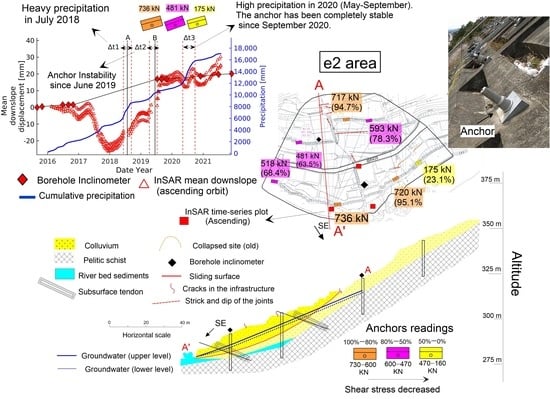Inclinometer and Improved SBAS Methods with a Random Forest for Monitoring Landslides and Anchor Degradation in Otoyo Town, Japan
Abstract
1. Introduction
2. Materials and Methods
2.1. General and Local Site Description
2.2. Borehole Inclinometer Data and Ground-Anchor Installation
2.3. InSAR Dataset and Methods
2.4. Auxiliary Remote Sensing Data
2.5. Application of Supervised Machine Learning to Mitigate Decorrelation
3. Results
3.1. Coherence-Based SBAS Measurement Results
3.2. Comparison of the Ground-Anchor Tension Force, Inclinometer, and InSAR Time Series
3.3. Random Forest Mask
4. Discussion
5. Conclusions
Author Contributions
Funding
Data Availability Statement
Acknowledgments
Conflicts of Interest
References
- Sasahara, K.; Ikeda, T.; Iwai, Y.; Kakuta, K.; Kanazawa, A.; Gonda, Y.; Saitou, Y.; Shuin, Y.; Tagata, S.; Fujita, M.; et al. Sediment disasters in Shikoku region in July, 2018. Int. J. Eros. Control Eng. 2019, 71, 43–53. [Google Scholar]
- Bru, G.; Escayo, J.; Fernández, J.; Mallorqui, J.J.; Iglesias, R.; Sansosti, E.; Abajo, T.; Morales, A. Suitability Assessment of X-Band Satellite SAR Data for Geotechnical Monitoring of Site Scale Slow Moving Landslides. Remote Sens. 2018, 10, 936. [Google Scholar] [CrossRef]
- Cook, M.E.; Brook, M.S.; Hamling, I.J.; Cave, M.; Tunnicliffe, J.F.; Holley, R.; Alama, D.J. Engineering geomorphological and InSAR investigation of an urban landslide, Gisborne, New Zealand. Landslides 2022, 19, 2423–2437. [Google Scholar] [CrossRef]
- Campbell, K.E.J.; Ruffell, A.; Pringle, J.; Hughes, D.; Taylor, S.; Devlin, B. Bridge Foundation River Scour and Infill Characterisation Using Water-Penetrating Radar. Remote Sens. 2021, 13, 2542. [Google Scholar] [CrossRef]
- Medhat, N.I.; Atya, M.; Ragab, E.A.; El-Kenawy, A.A.; Zaher, M.A.; Pringle, J.K. Geophysical site assessment of an active urban development site, southeastern suburb of Cairo, Egypt. Q. J. Eng. Geol. Hydrogeol. 2021, 54, qjegh2018-151. [Google Scholar] [CrossRef]
- Tofani, V.; Raspini, F.; Catani, F.; Casagli, N. Persistent scatterer interferometry (psi) technique for landslide characterization and monitoring. Remote Sens. 2013, 5, 1045–1065. [Google Scholar] [CrossRef]
- Bordoni, M.; Vivaldi, V.; Bonì, R.; Spanò, S.; Tararbra, M.; Lanteri, L.; Parnigoni, M.; Grossi, A.; Figini, S.; Meisina, C. A methodology for the analysis of continuous time-series of automatic inclinometers for slow-moving landslides monitoring in Piemonte region, northern Italy. Nat. Hazards 2022. [Google Scholar] [CrossRef]
- Fujiwara, Y.; Sakai, T. A Study of a Lift-Off Test Method for Ground Anchors. J. JSCE 2016, 4, 106–117. [Google Scholar] [CrossRef]
- Kelevitz, K.; Novellino, A.; Watlet, A.; Boyd, J.; Whiteley, J.; Chambers, J.; Jordan, C.; Wright, T.; Hooper, A.; Biggs, J. Ground and Satellite-Based Methods of Measuring Deformation at a UK Landslide Observatory: Comparison and Integration. Remote Sens. 2022, 14, 2836. [Google Scholar] [CrossRef]
- Ao, M.; Zhang, L.; Dong, Y.; Su, L.; Shi, X.; Balz, T.; Liao, M. Characterizing the evolution life cycle of the Sunkoshi landslide in Nepal with multi-source SAR data. Sci. Rep. 2020, 10, 1–12. [Google Scholar] [CrossRef]
- Hamama, I.; Yamamoto, M.-Y.; ElGabry, M.N.; Medhat, N.I.; Elbehiri, H.S.; Othman, A.S.; Abdelazim, M.; Lethy, A.; El-hady, S.M.; Hussein, H. Investigation of near-surface chemical explosions effects using seismo-acoustic and synthetic aperture radar analyses. J. Acoust. Soc. Am. 2022, 151, 1575–1592. [Google Scholar] [CrossRef] [PubMed]
- Zhang, T.; Shen, W.B.; Wu, W.; Zhang, B.; Pan, Y. Recent surface deformation in the Tianjin area revealed by Sentinel-1A data. Remote Sens. 2019, 11, 130. [Google Scholar] [CrossRef]
- Darwish, N.; Kaiser, M.; Koch, M.; Gaber, A. Assessing the accuracy of alos/palsar-2 and sentinel-1 radar images in estimating the land subsidence of coastal areas: A case study in alexandria city, egypt. Remote Sens. 2021, 13, 1838. [Google Scholar] [CrossRef]
- Wasowski, J.; Pisano, L. Long-term InSAR, borehole inclinometer, and rainfall records provide insight into the mechanism and activity patterns of an extremely slow urbanized landslide. Landslides 2020, 17, 445–457. [Google Scholar] [CrossRef]
- Novellino, A.; Cesarano, M.; Cappelletti, P.; Di Martire, D.; Di Napoli, M.; Ramondini, M.; Sowter, A.; Calcaterra, D. Slow-moving landslide risk assessment combining Machine Learning and InSAR techniques. Catena 2021, 203, 105317. [Google Scholar] [CrossRef]
- Xia, Z.; Motagh, M.; Li, T.; Roessner, S. The June 2020 Aniangzhai landslide in Sichuan Province, Southwest China: Slope instability analysis from radar and optical satellite remote sensing data. Landslides 2022, 19, 313–329. [Google Scholar] [CrossRef]
- Jacquemart, M.; Tiampo, K. Leveraging time series analysis of radar coherence and normalized difference vegetation index ratios to characterize pre-failure activity of the Mud Creek landslide, California. Nat. Hazards Earth Syst. Sci. 2021, 21, 629–642. [Google Scholar] [CrossRef]
- Bai, Z.; Fang, S.; Gao, J.; Zhang, Y.; Jin, G.; Wang, S.; Zhu, Y.; Xu, J. Could Vegetation Index be Derive from Synthetic Aperture Radar?—The Linear Relationship between Interferometric Coherence and NDVI. Sci. Rep. 2020, 10, 6749. [Google Scholar] [CrossRef]
- Jacob, A.W.; Notarnicola, C.; Suresh, G.; Antropov, O.; Ge, S.; Praks, J.; Ban, Y.; Pottier, E.; Mallorqui Franquet, J.J.; Duro, J.; et al. Sentinel-1 InSAR Coherence for Land Cover Mapping: A Comparison of Multiple Feature-Based Classifiers. IEEE J. Sel. Top. Appl. Earth Obs. Remote Sens. 2020, 13, 535–552. [Google Scholar] [CrossRef]
- Confuorto, P.; Medici, C.; Bianchini, S.; Del Soldato, M.; Rosi, A.; Segoni, S.; Casagli, N. Machine Learning for Defining the Probability of Sentinel-1 Based Deformation Trend Changes Occurrence. Remote Sens. 2022, 14, 1748. [Google Scholar] [CrossRef]
- Sato, G.; Ozaki, T.; Yokoyama, O.; Wakai, A.; Hayashi, K.; Yamasaki, T.; Tosa, S.; Mayumi, T.; Kimura, T. New approach for the extraction method of landslide-prone slopes using geomorphological analysis: Feasibility study in the Shikoku mountains, Japan. J. Disaster Res. 2021, 16, 618–625. [Google Scholar] [CrossRef]
- Notti, D.; Herrera, G.; Bianchini, S.; Meisina, C.; García-Davalillo, J.C.; Zucca, F. A methodology for improving landslide PSI data analysis. Int. J. Remote Sens. 2014, 35, 2186–2214. [Google Scholar] [CrossRef]
- Fang, G.W.; Zhu, Y.P.; Ye, S.H.; Huang, A.P. Analysis of force and displacement of anchor systems under the non-limit active state. Sci. Rep. 2022, 12, 1306. [Google Scholar] [CrossRef]
- Medhat, N.I.; Yamamoto, M.-Y.; Tolomei, C.; Harbi, A.; Maouche, S. Multi-temporal InSAR analysis to monitor landslides using the small baseline subset (SBAS) approach in the Mila Basin, Algeria. Terra Nova 2022, 34, 407–423. [Google Scholar] [CrossRef]
- Pawluszek-Filipiak, K.; Borkowski, A. Integration of DInSAR and SBAS techniques to determine mining-related deformations using Sentinel-1 data: The case study of rydultowy mine in Poland. Remote Sens. 2020, 12, 242. [Google Scholar] [CrossRef]
- Chen, C.; Zebker, H. Phase unwrapping for large SAR interferograms: Statistical segmentation and generalized network models. IEEE Trans. Geosci. Remote Sens. 2002, 40, 1709–1719. [Google Scholar] [CrossRef]
- Berardino, P.; Fornaro, G.; Lanari, R.; Sansosti, E. A new algorithm for surface deformation monitoring based on small baseline differential SAR interferograms. IEEE Trans. Geosci. Remote Sens. 2002, 40, 2375–2383. [Google Scholar] [CrossRef]
- Sandwell, D.; Mellors, R.; Tong, X.; Wei, M.; Wessel, P. Open radar interferometry software for mapping surface Deformation. Eos Trans. Am. Geophys. Union 2011, 92, 234. [Google Scholar] [CrossRef]
- Cianflone, G.; Tolomei, C.; Brunori, C.A.; Monna, S.; Dominici, R. Landslides and subsidence assessment in the Crati Valley (Southern Italy) using insar data. Geosciences 2018, 8, 67. [Google Scholar] [CrossRef]
- Tymofyeyeva, E.; Fialko, Y. Mitigation of atmospheric phase delays in InSAR data, with application to the eastern California shear zone. J. Geophys. Res. Solid Earth 2015, 120, 5952–5963. [Google Scholar] [CrossRef]
- Tong, X.; Schmidt, D. Active movement of the Cascade landslide complex in Washington from a coherence-based InSAR time series method. Remote Sens. Environ. 2016, 186, 405–415. [Google Scholar] [CrossRef]
- Liang, J.; Dong, J.; Zhang, S.; Zhao, C.; Liu, B.; Yang, L.; Yan, S.; Ma, X. Discussion on InSAR Identification Effectivity of Potential Landslides and Factors That Influence the Effectivity. Remote Sens. 2022, 14, 1952. [Google Scholar] [CrossRef]
- Morishita, Y. Nationwide urban ground deformation monitoring in Japan using Sentinel-1 LiCSAR products and LiCSBAS. Prog. Earth Planet. Sci. 2021, 8, 6. [Google Scholar] [CrossRef]
- Mirmazloumi, S.M.; Gambin, A.F.; Palam, R.; Crosetto, M. Supervised Machine Learning Algorithms for Ground Motion Time Series Supervised Machine Learning Algorithms for Ground Motion Time Series Classification from InSAR Data. Remote Sens. 2022, 14, 3821. [Google Scholar] [CrossRef]
- Karlsen, S.R.; Stendardi, L.; Tømmervik, H.; Nilsen, L.; Arntzen, I.; Cooper, E.J. Time-series of cloud-free sentinel-2 ndvi data used in mapping the onset of growth of central spitsbergen, svalbard. Remote Sens. 2021, 13, 3031. [Google Scholar] [CrossRef]
- Karimzadeh, S.; Matsuoka, M.; Miyajima, M.; Adriano, B.; Fallahi, A.; Karashi, J. Sequential SAR coherence method for the monitoring of buildings in Sarpole-Zahab, Iran. Remote Sens. 2018, 10, 1255. [Google Scholar] [CrossRef]
- Béjar-Pizarro, M.; Notti, D.; Mateos, R.M.; Ezquerro, P.; Centolanza, G.; Herrera, G.; Bru, G.; Sanabria, M.; Solari, L.; Duro, J.; et al. Mapping Vulnerable Urban Areas Affected by Slow-Moving Landslides Using Sentinel-1 InSAR Data. Remote Sens. 2017, 9, 876. [Google Scholar] [CrossRef]
- Bayramov, E.; Buchroithner, M.; Kada, M.; Zhuniskenov, Y. Quantitative assessment of vertical and horizontal deformations derived by 3d and 2d decompositions of insar line-of-sight measurements to supplement industry surveillance programs in the tengiz oilfield (Kazakhstan). Remote Sens. 2021, 13, 2579. [Google Scholar] [CrossRef]
- Japan Anchor Association. Inspection and Maintenance Manual for Ground Anchors; Japan Anchor Association: Tokyo, Japan, 2015. [Google Scholar]
- Hamasaki, T.; Kasama, K.; Maeda, Y. Deterioration model of ground anchor for slope stability assessment. Jpn. Geotech. Soc. Spec. Publ. 2015, 2, 2461–2464. [Google Scholar] [CrossRef]
- Liu, L.; Millar, C.I.; Westfall, R.D.; Zebker, H.A. Surface motion of active rock glaciers in the Sierra Nevada, California, USA: Inventory and a case study using InSAR. Cryosphere 2013, 7, 1109–1119. [Google Scholar] [CrossRef]
- Handwerger, A.L.; Fielding, E.J.; Sangha, S.S.; Bekaert, D.P. Landslide Sensitivity and Response to Precipitation Changes in Wet and Dry Climates. Geophys. Res. Lett. 2022, 49, e2022GL099499. [Google Scholar] [CrossRef] [PubMed]
- Burrows, K.; Milledge, D.; Walters, R.; Bellugi, D. Improved rapid landslide detection from integration of empirical models and satellite radar. Nat. Hazards Earth Syst. Sci. 2021, 765, 1–34. [Google Scholar]
- Pedregosa, F.; Varoquaux, G.; Gramfort, A.; Michel, V.; Thirion, B.; Grisel, O.; Blondel, M.; Prettenhofer, P.; Weiss, R.; Dubourg, V.; et al. Scikit-learn: Machine Learning in Python. J. Mach. Learn. Res. 2011, 12, 2825–2830. [Google Scholar]
- Ziegler, A.; König, I.R. Mining data with random forests: Current options for real-world applications. WIREs Data Min. Knowl. Discov. 2014, 4, 55–63. [Google Scholar] [CrossRef]
- Bovenga, F.; Pasquariello, G.; Pellicani, R.; Refice, A.; Spilotro, G. Landslide monitoring for risk mitigation by using corner reflector and satellite SAR interferometry: The large landslide of Carlantino (Italy). Catena 2017, 151, 49–62. [Google Scholar] [CrossRef]
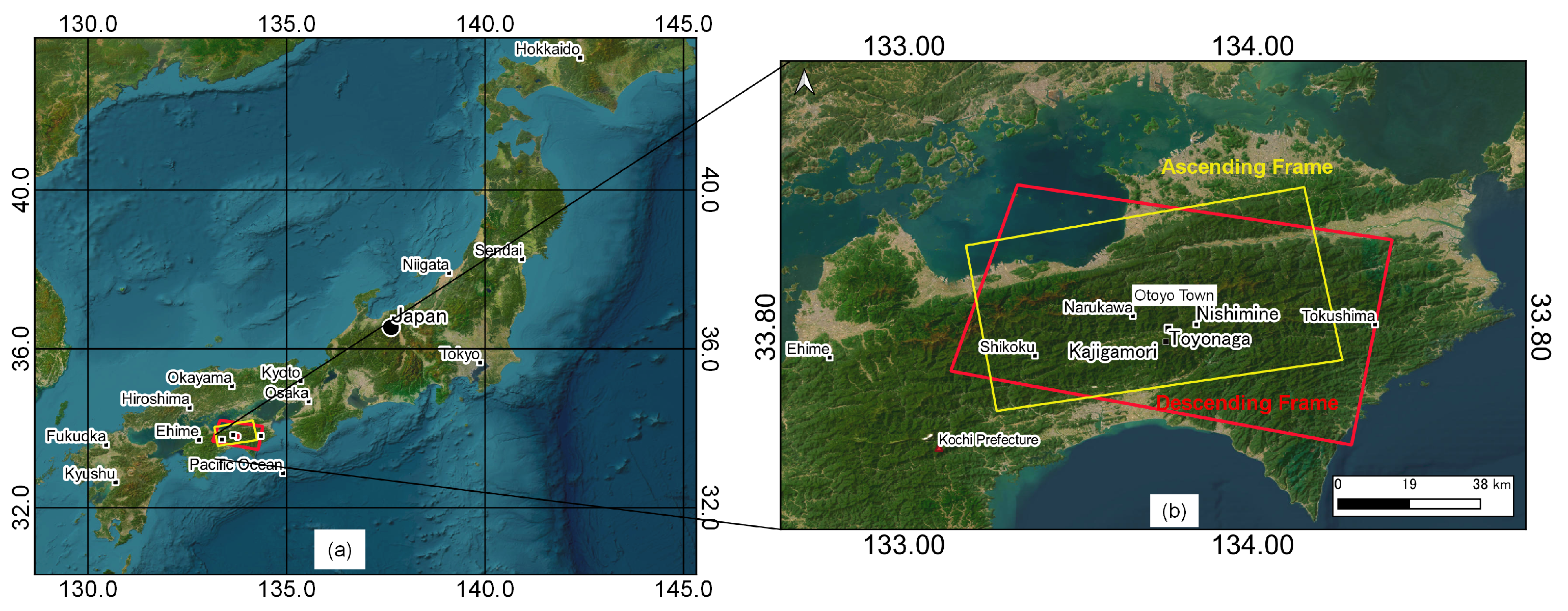
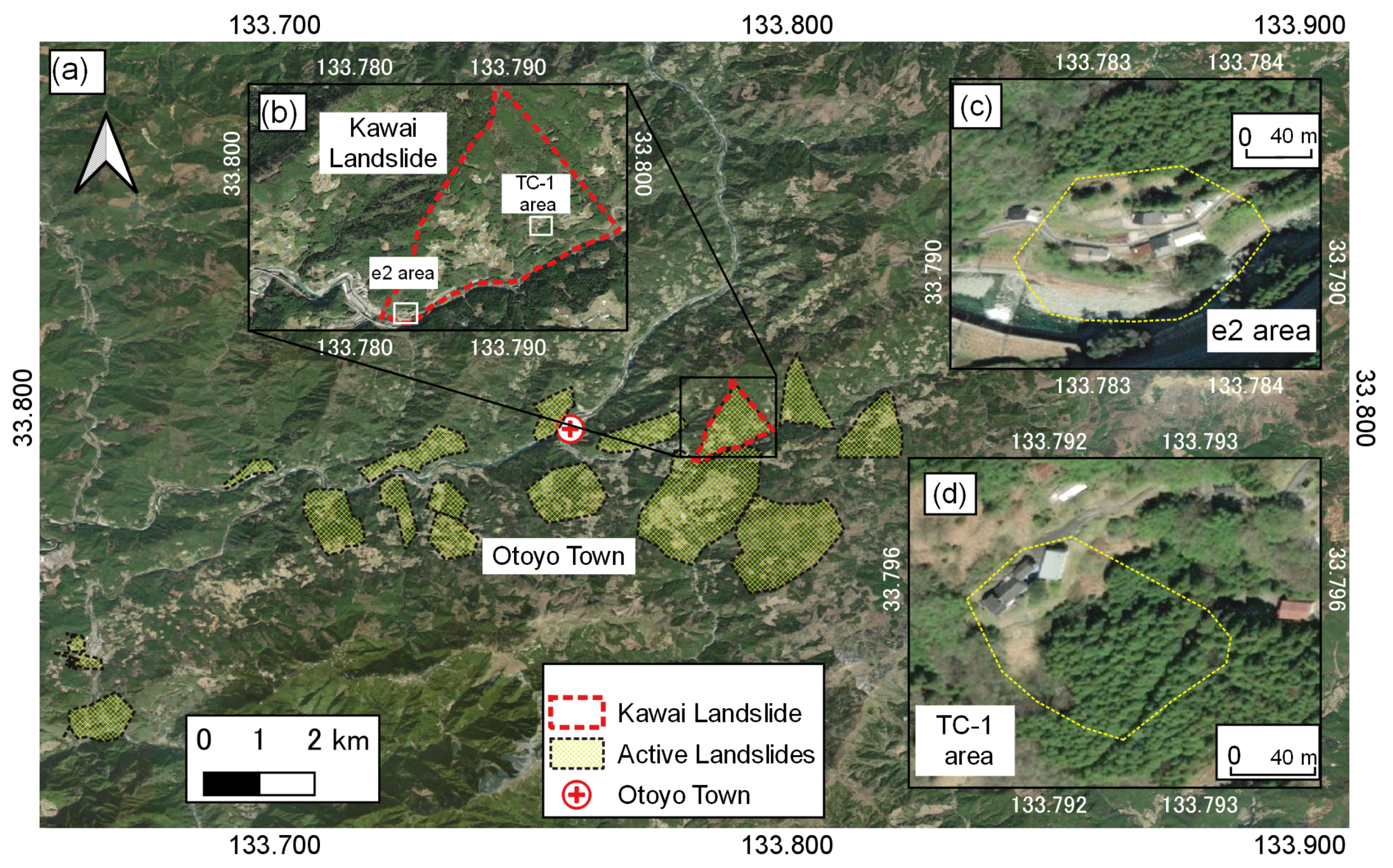
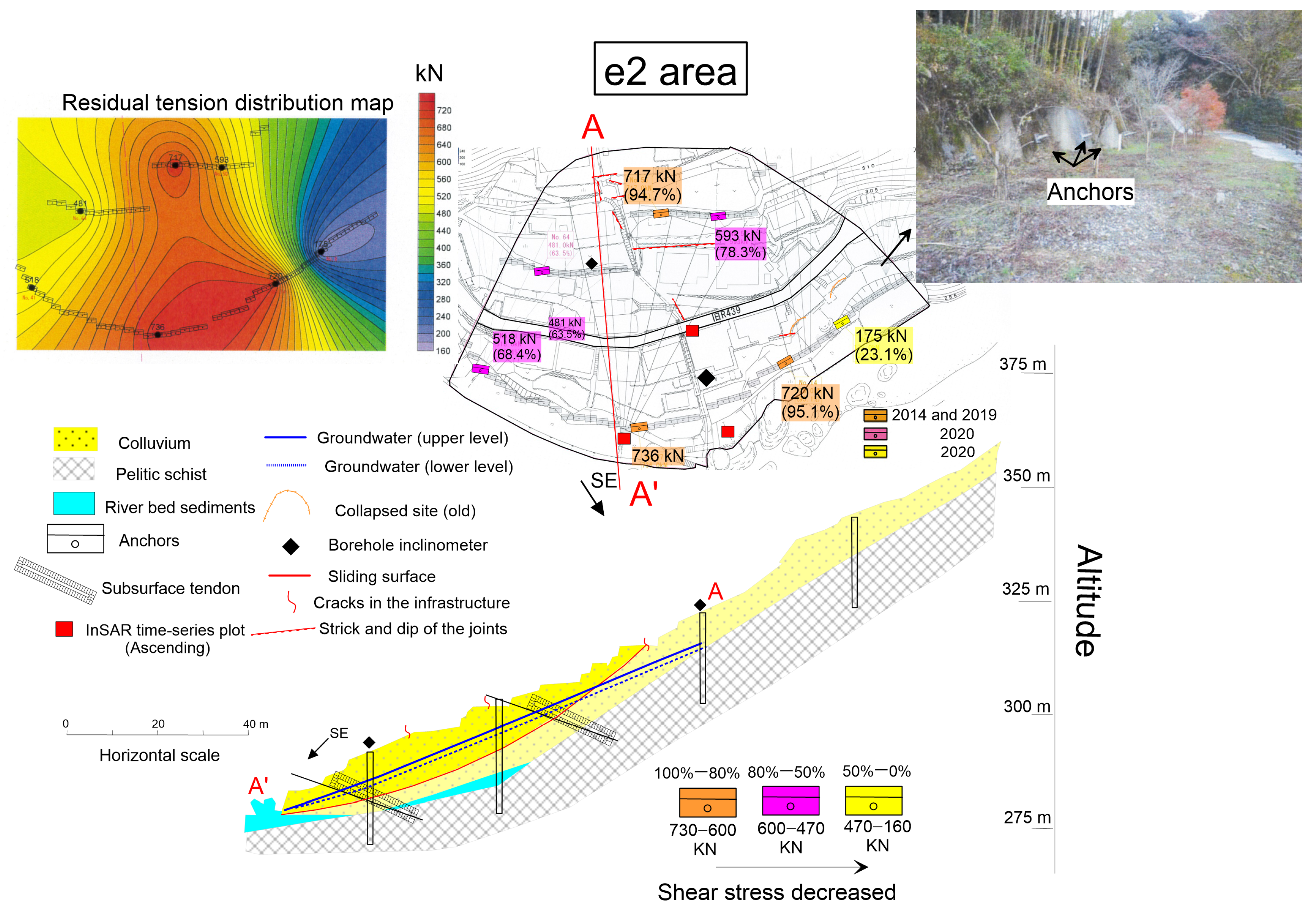
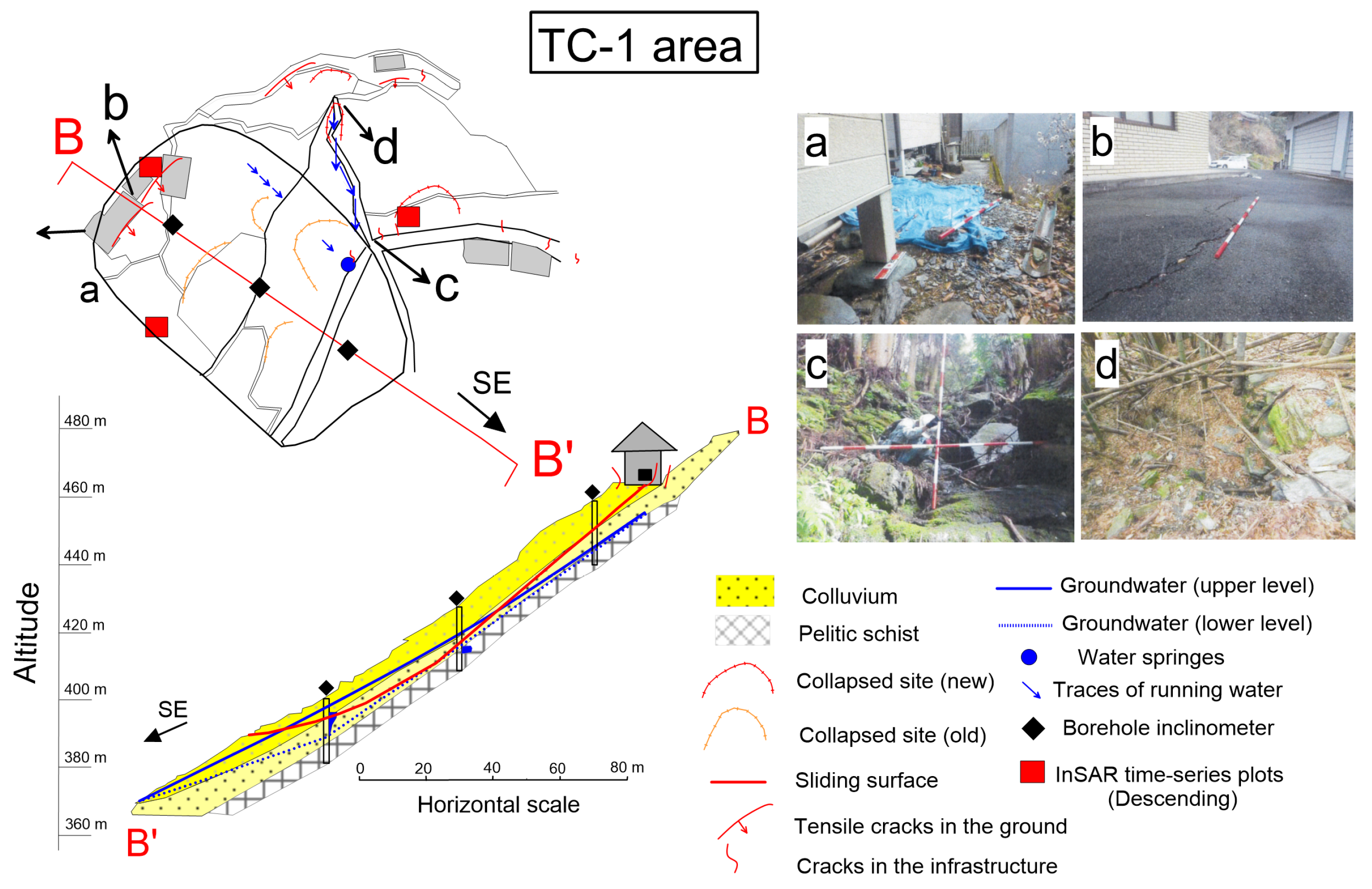
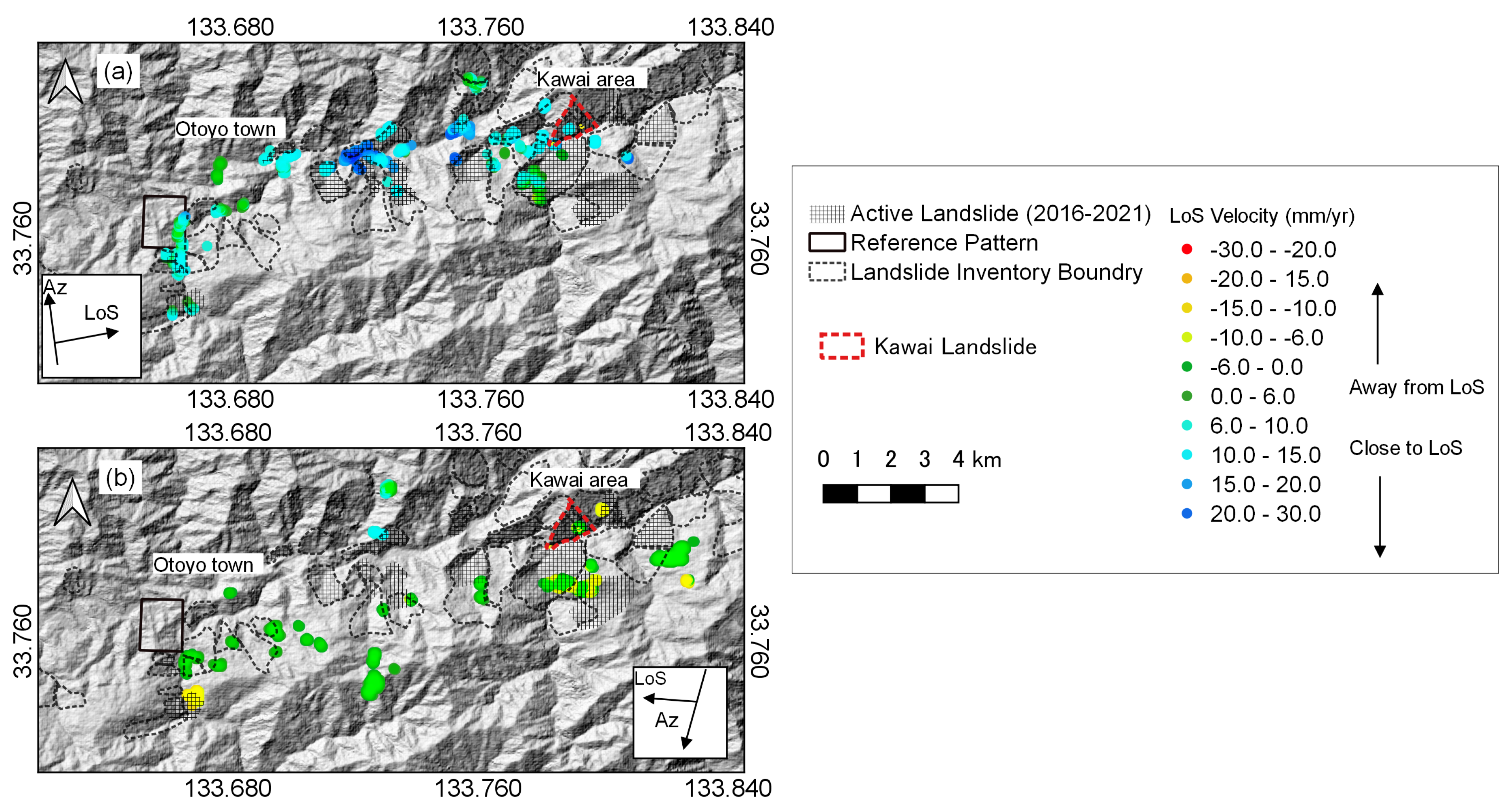
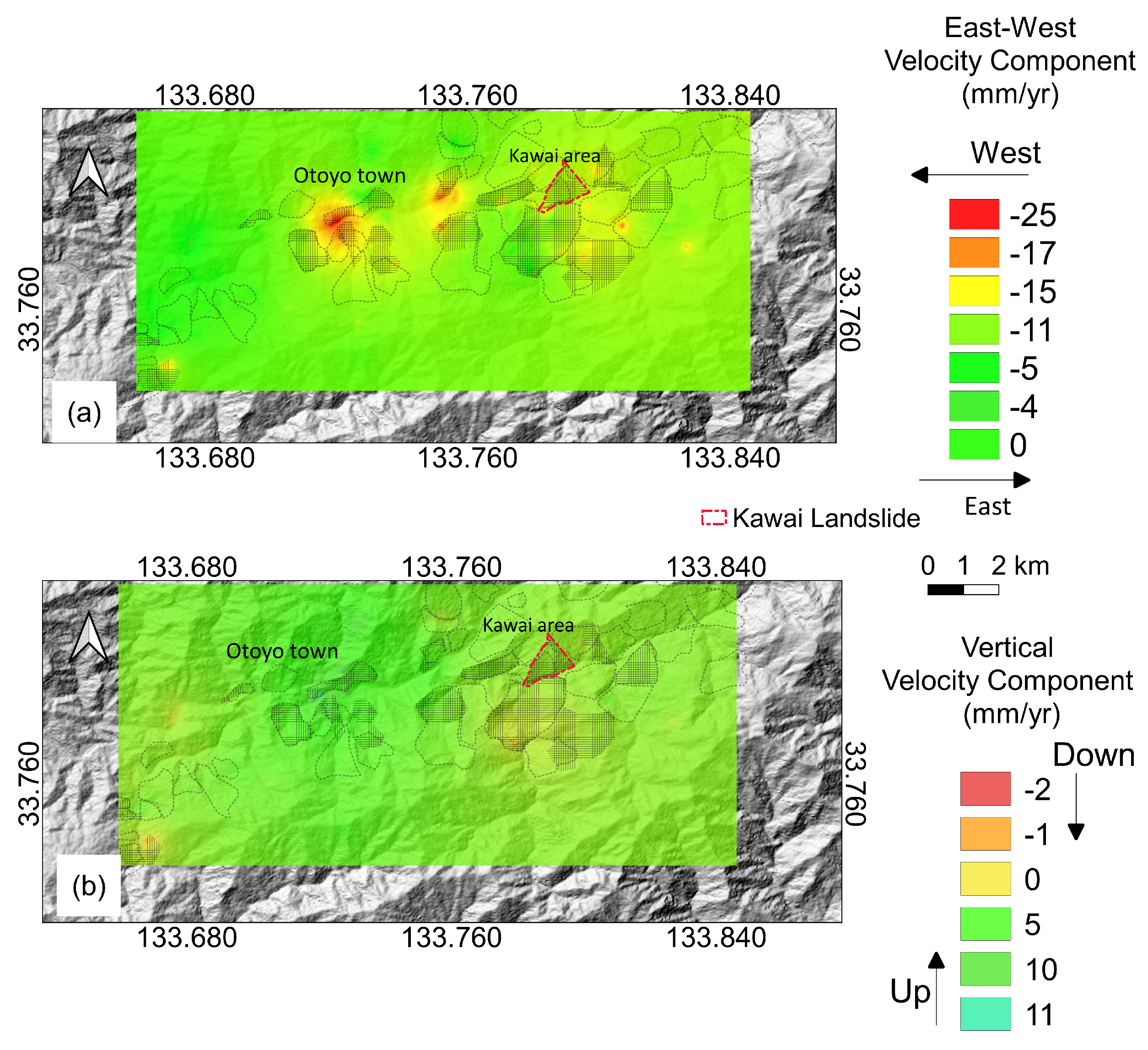
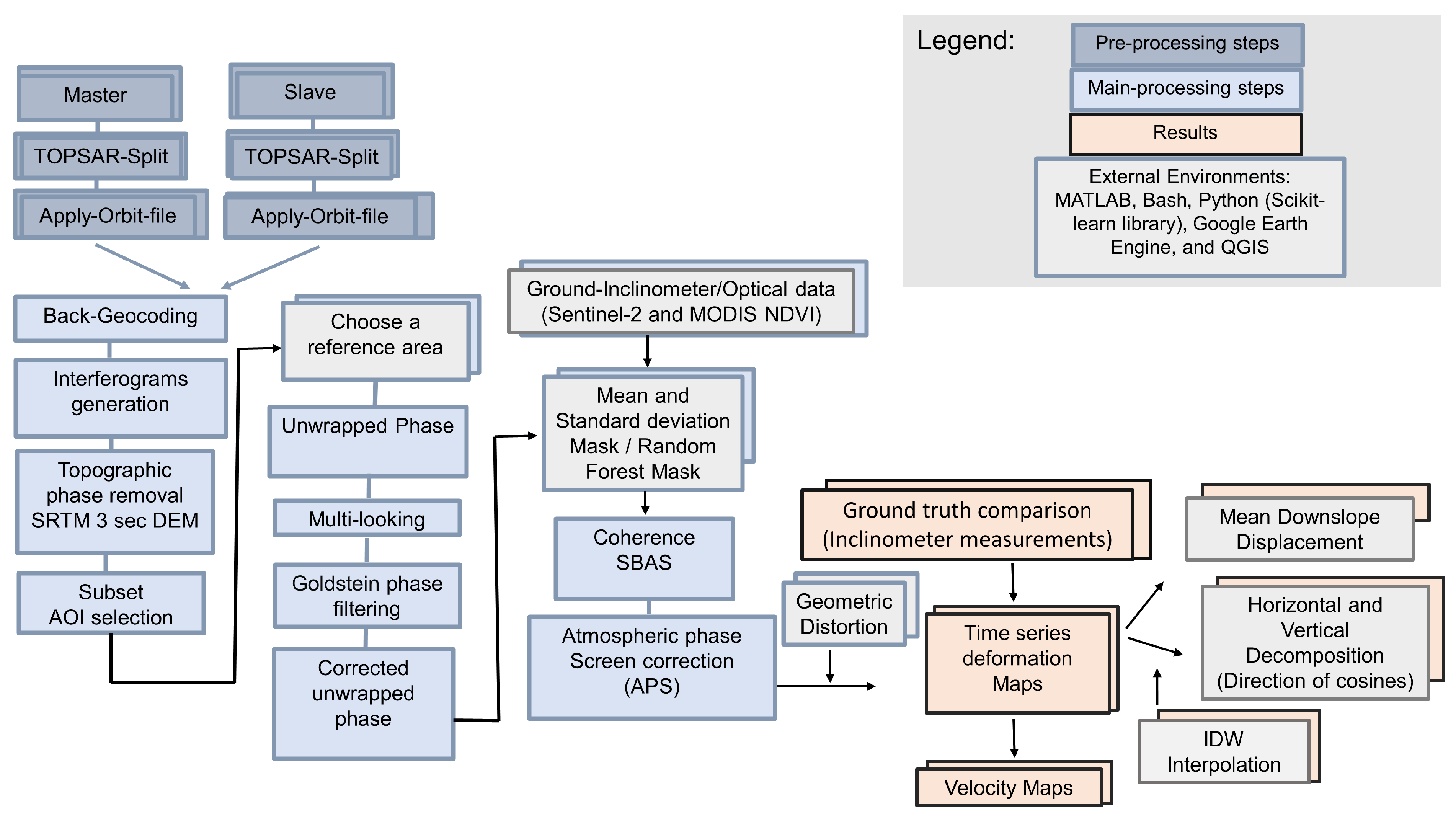
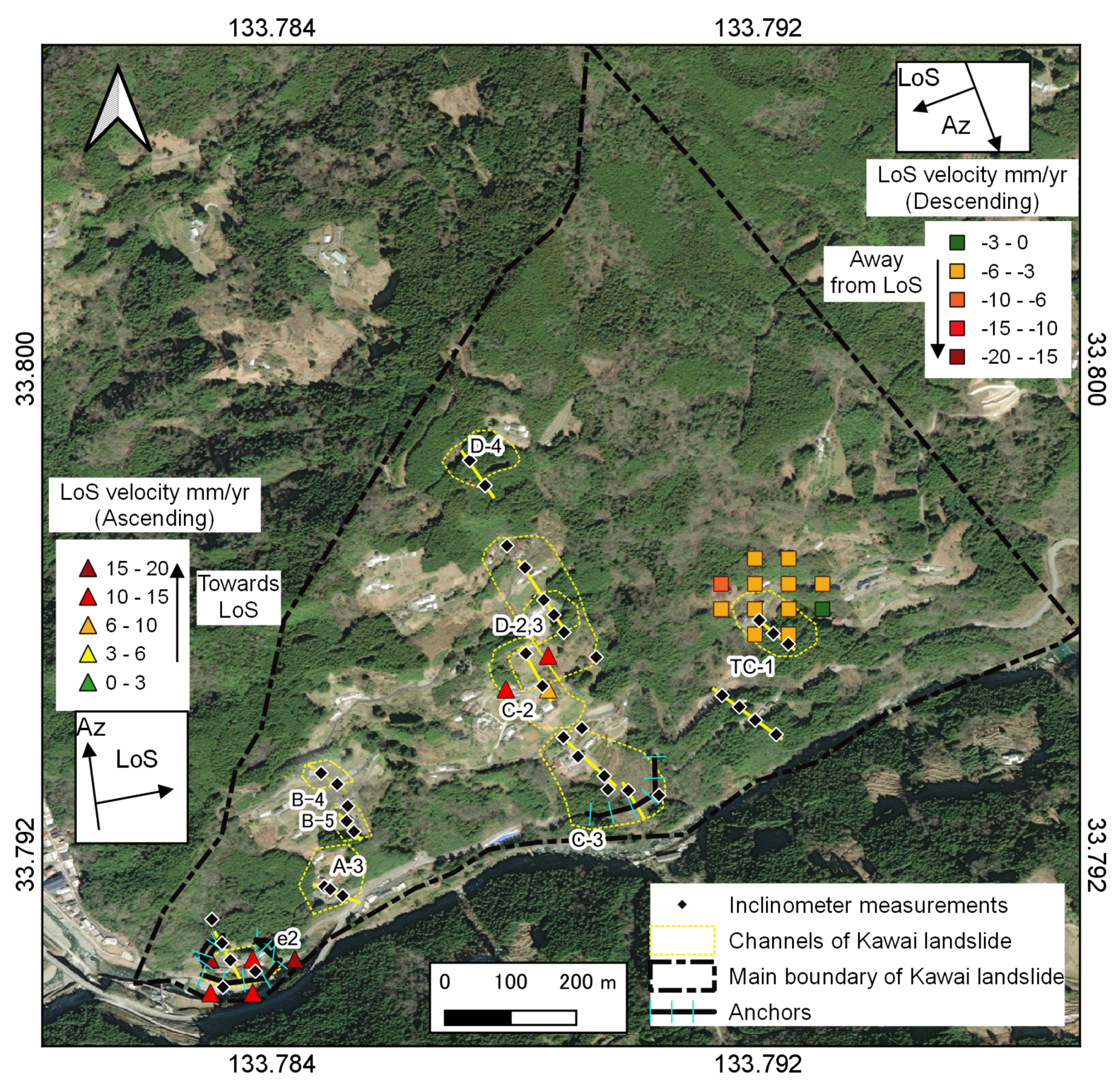

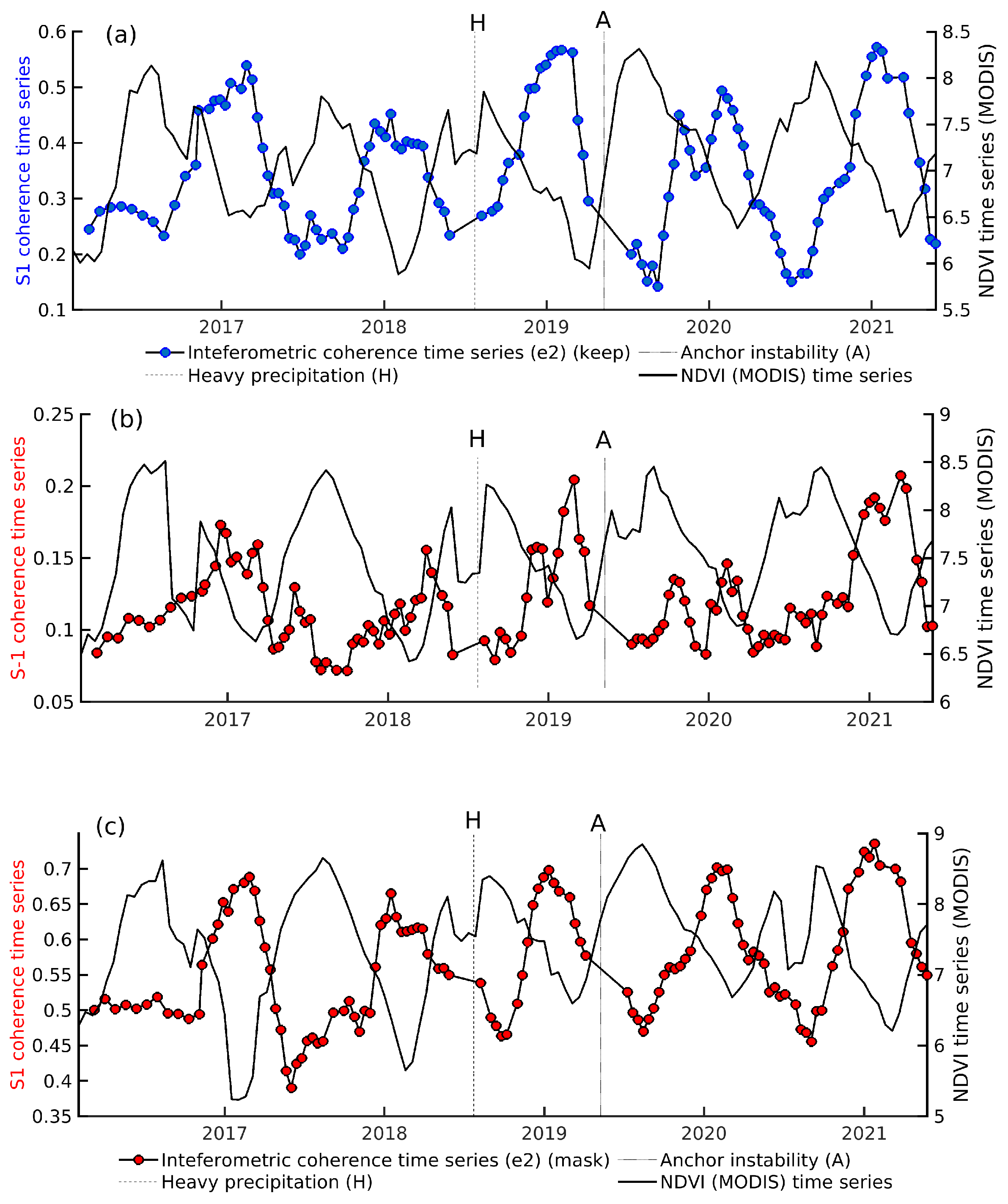
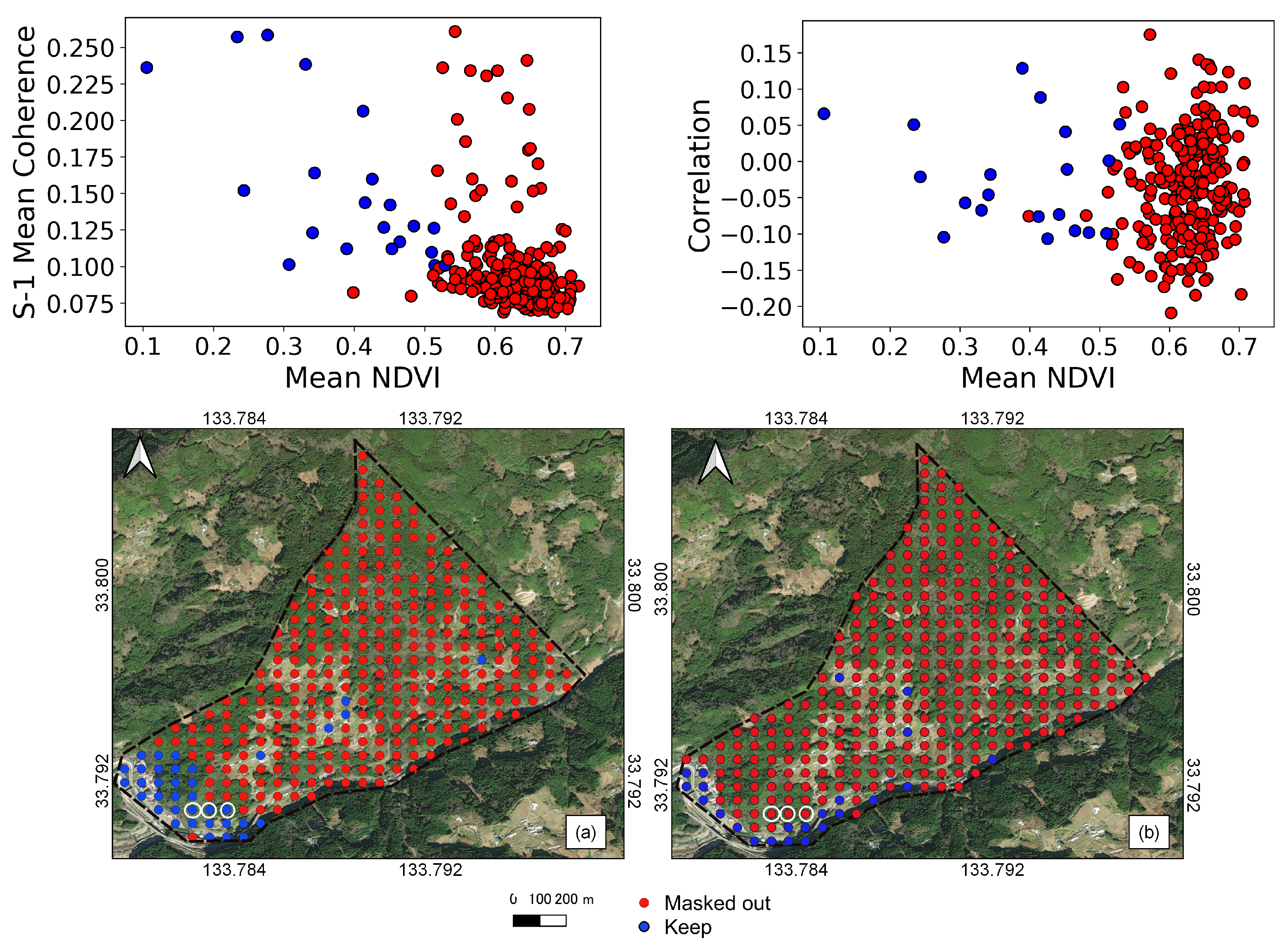
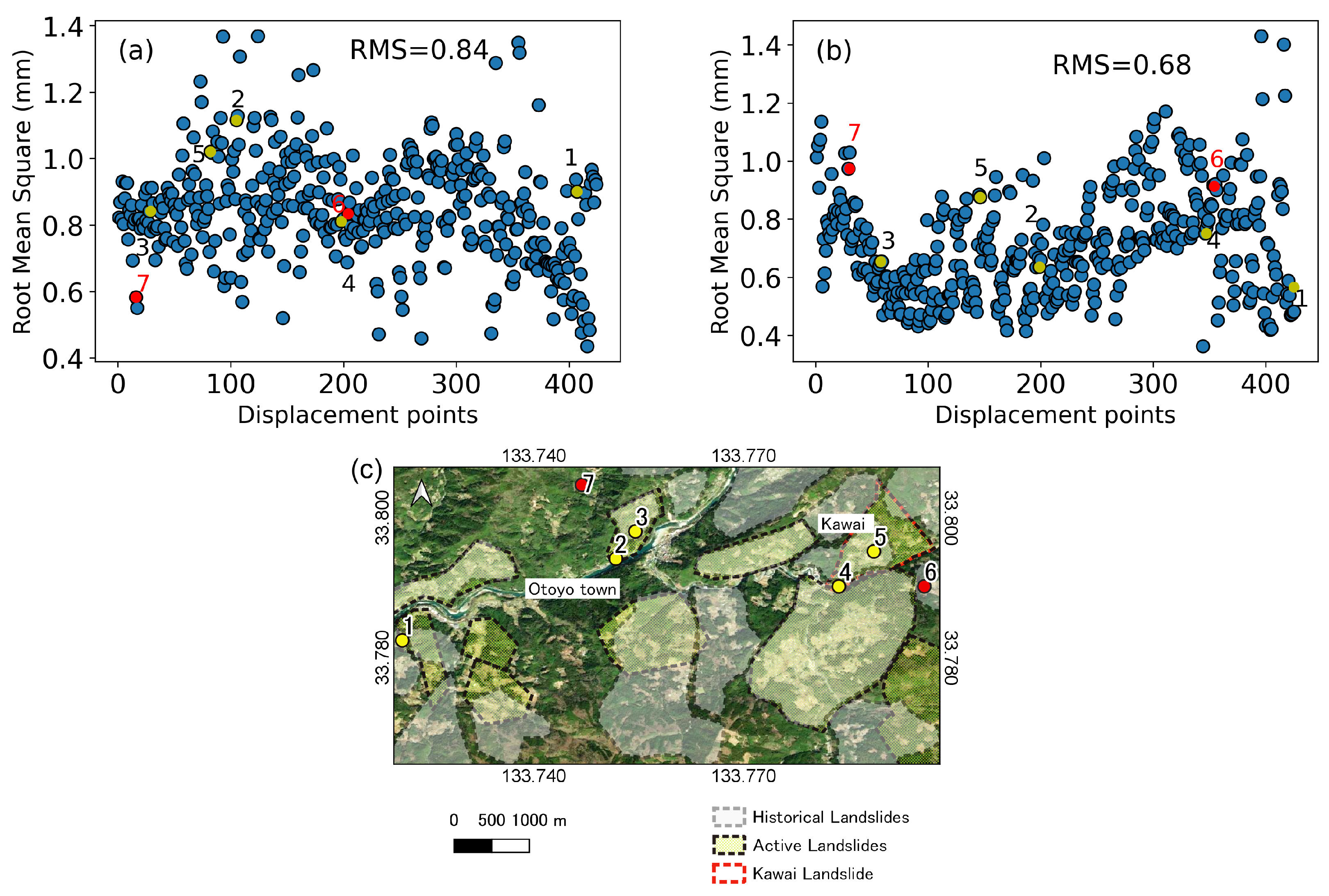
| t1 (e2) | t2 (e2) | t3 (e2) |
|---|---|---|
| Heavy precipitation occurred in July 2018 (June–September) | Precipitation and anchor instability in June 2019 (April–July) | Precipitation in 2020 (May–September). The anchor has been completely stable since 2020 |
| t1 (TC-1) | t2 (TC-1) | t3 and t4 (TC-1) |
|---|---|---|
| Heavy precipitation in July 2018 (June–September) | Precipitation in June 2019 (April–July), inhabitants reported cracks | Precipitation from May to September 2020. From August 2020 to August 2021, the area was unstable |
| Time Increment of the e2 Area | t1 | t2 | t3 |
|---|---|---|---|
| Cumulative precipitation (mm) | 2630 | 1070 | 3520 |
| InSAR displacement [MSD mask] (mm) | 11.8 | 11.4 | 1.1 |
| InSAR displacement [RF mask] (mm) | 3.5 | 10.5 | 0.7 |
| Inclinometer Measurements | November 2016–June 2019 | October 2019–November 2020 | |
| Displacement (mm) | 15.46 | 1.7 |
Disclaimer/Publisher’s Note: The statements, opinions and data contained in all publications are solely those of the individual author(s) and contributor(s) and not of MDPI and/or the editor(s). MDPI and/or the editor(s) disclaim responsibility for any injury to people or property resulting from any ideas, methods, instructions or products referred to in the content. |
© 2023 by the authors. Licensee MDPI, Basel, Switzerland. This article is an open access article distributed under the terms and conditions of the Creative Commons Attribution (CC BY) license (https://creativecommons.org/licenses/by/4.0/).
Share and Cite
Medhat, N.I.; Yamamoto, M.-Y.; Ichihashi, Y. Inclinometer and Improved SBAS Methods with a Random Forest for Monitoring Landslides and Anchor Degradation in Otoyo Town, Japan. Remote Sens. 2023, 15, 441. https://doi.org/10.3390/rs15020441
Medhat NI, Yamamoto M-Y, Ichihashi Y. Inclinometer and Improved SBAS Methods with a Random Forest for Monitoring Landslides and Anchor Degradation in Otoyo Town, Japan. Remote Sensing. 2023; 15(2):441. https://doi.org/10.3390/rs15020441
Chicago/Turabian StyleMedhat, Noha Ismail, Masa-Yuki Yamamoto, and Yoshiharu Ichihashi. 2023. "Inclinometer and Improved SBAS Methods with a Random Forest for Monitoring Landslides and Anchor Degradation in Otoyo Town, Japan" Remote Sensing 15, no. 2: 441. https://doi.org/10.3390/rs15020441
APA StyleMedhat, N. I., Yamamoto, M.-Y., & Ichihashi, Y. (2023). Inclinometer and Improved SBAS Methods with a Random Forest for Monitoring Landslides and Anchor Degradation in Otoyo Town, Japan. Remote Sensing, 15(2), 441. https://doi.org/10.3390/rs15020441







